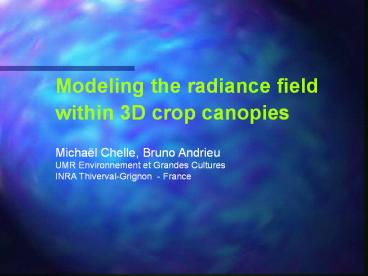Pr PowerPoint PPT Presentation
Title: Pr
1
Modeling the radiance field within 3D crop
canopies Michaël Chelle, Bruno Andrieu UMR
Environnement et Grandes Cultures INRA
Thiverval-Grignon - France
2
Modeling 3D light transfer
Light-leaf interaction
incident
reflection
absorption
transmission
3
Modeling 3D light transfer
Light-leaves interactions
Complexity of solving this equation depends on
the number of surfaces Sy
gt Not working on a whole canopy, but on a
significant pattern 8 duplicated
4
First order of scattering
Projection (Z-buffer)
Efficient treatment of periodic infinite canopy
Canopy gap fraction gt single Z-buffer Monogap
Canopy BRDF gt double Z-buffer Bvis (B.
Andrieu, 1999)
5
First order of scattering
Example of application Estimation of the
clumping parameter
6
Multiple scattering
Monte Carlo ray tracing Ross Marshak (1988)
ART (Dauzat, 1991) Raytran (Govaerts, 1994),
North(1996), BPMS (Lewis, 1999), Following
stochastically the propagation of light rays
within a 3D canopy Our Monte Carlo ray tracing
PARCINOPY
- Polygons set, various leaf BRDF
- Multispectral work in progress
Classic CG algorithms
Numerous output variables (not only canopy
reflectance) Canopy BRDF, gap fraction,
Profile of mean fluxes, radiance distrib
virtual sensors polygons irradiance
each variable may be given by scattering order
Estimation of the variance of each output
Few assumptions, but Computing-time consuming
7
Multiple scattering
Illustrations of parcinopy uses
- Generation of reference dataset nested
radiosity, Kuusk (97), Shabanov (2000) - Analysis of sensitivity leaf BRDF, Plant
geometry (Espana et al)
- Study of radiative transfer what about fluxes
isotropy? scattering order?
8
Multiple scattering
A more efficient method radiosity Borel
(1991) Goel (1991), Garcia-Haro (2002),
- A radiosity model consists in
- computing the N2 form factors between each
leaf - solving the resulting system of linear equations
- Two limitations of the radiosity method
- the N2 complexity
- the Lambertian approximation
9
Multiple scattering
A dedicated radiosity method for canopy the
nested radiosity (Chelle et Andrieu, 1998)
? For each triangle, a sphere defines the close
objects
? The far radiations are estimated by a TM model
SAIL
Designed to estimate leaf irradiances,
a Z-buffer projection may be used to estimate
canopy BRDF from these
10
Modeling 3D light transfer
Several questions remains
- What about the 3D structure accuracy?
- Quid about moving plants ?
- How detailed should be the optical properties ?
- Are these approaches also suitable for forest
canopy? - What about needles?
- Experimental dataset ?
- Should the 3D approaches be restricted to the
theoretical studies - to improve efficient TM models (hot spot,
clumping,) - or be used to design operational methods?
11
Conclusion
Combining accurate 3D canopies and 3D RT tools
- Provide tools to investigate light-canopy
interactions and the properties of resulting
fluxes - Provide reference dataset
Basis to develop efficient, but correct RT
models to analyze remote sensing data
12
(No Transcript)
13
(No Transcript)
14
?0 lt1
?0 1
15
Sensivity to the sphere diameter the case of
maize

